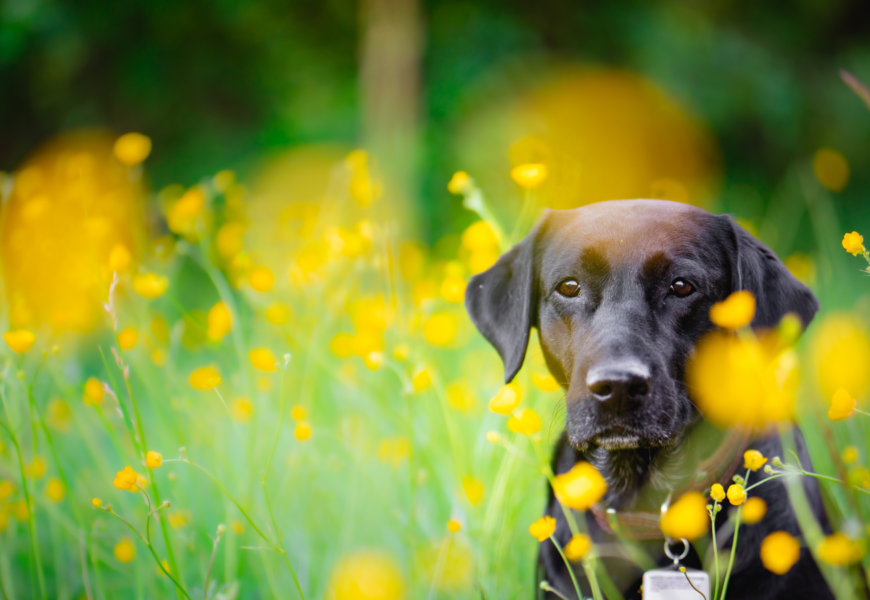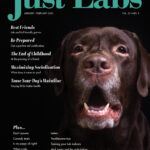by Jillian LaCross
A harmonious relationship with your Lab depends on more than a nice personality.
The Labrador retriever as a breed has a solid reputation as being family friendly, approachable, and intuitive. Although these traits may be mostly true for most Labs without their even trying, your Lab is an individual as well and may act or learn differently than what is considered “standard”; or it may simply take time for him to develop into that ideal dog. We take a lot of Labrador retriever personality traits for granted, and when pitfalls happen, we wonder how all that breeding let us down.
But a dog is more than just breeding. It’s true that nature helps set the groundwork for a wonderful lifelong relationship; however, it’s important to avoid making certain assumptions about your dog’s behavior and activity simply because of the breed’s sterling reputation. If you do, you or your Lab could find yourself in a pickle.
So, don’t assume…
…your Lab knows how to walk on a leash. Labs love being by their humans, but their nature often leads them to follow their senses and explore on their own – and they will leave you behind. Labs are natural hunters and can be downright bullheaded in pursuing what they want to pursue, dragging you in the process. Being attached and behaving politely on a leash is a skill that needs to be learned. “It’s not going to happen automatically,” says Laurie Williams, dog behavior consultant and owner/training director of Pup ’N Iron Canine Fitness & Learning Center in Fredericksburg, Virginia. “My recommendation is to find a dog training class or hire a dog trainer. That will give you some tips to start leash walking. It’s just a process of repetition, using food or toys for positive reinforcement, and building up a lot of engagement so that the dog wants to work with you and have fun while doing it.” Walking on a leash is not natural for a dog; they tend to fight against it. Following Williams’ advice will help ensure you and your Lab are both happy when you’re connected through a leash.

…your Lab knows how to manage distractions. Distractions can be anything that takes your Lab’s attention away from you – and that seems to be more interesting than you. Labs aim to please, but they can get easily distracted. “It’s normal to be distracted, and you do have to get out there to expose them to distractions,” says Williams. But she gently reminds owners that dogs don’t know how to avoid being distracted without training. Get the dog to learn how to execute the skill and then slowly add distractions from there. “You want to start far away from distraction and do a lot of positive reinforcement while the dog is paying attention to you. The problem is, people want to go downtown or to a farmer’s market right away. You can’t work on distraction when a dog is flooded with them. You want to get the dog comfortable and attentive with a distraction that’s farther away, then move closer and closer over time.” For instance, start by going to a park and staying 30 feet away from kids playing on the playground. Eventually, your Lab will get acclimated to the distraction, and then you can move closer after a few visits.
…your Lab knows how to behave around kids and/or other dogs. Labs have a propensity for gentleness, kindness, and being good-natured. These are big reasons why the breed is so popular. But they can be overly enthusiastic, not realize the impact of their size, and get easily bored, which can lead to poor behavior. And if there is a health issue causing distress or pain, even the nicest dogs can react badly. Even though Labs have very social, peaceful personalities and are generally good around other dogs and kids, even young ones, your Lab still needs training. “You do have to watch them. Even if they have a nice temperament, they may still not be appropriate. A friendly dog can be just as much of a nuisance as a non-friendly dog,” says Williams. For example, toddlers can be eye level with a dog and the dog licks the toddler right in the face. “You don’t necessarily want your dog doing that. Why would he know not to do that? They don’t come with that programmed into them. They still need to be taught manners and follow directions.” Even if people don’t mind your Lab’s behavior, as the owner, you need to make sure you are comfortable with it and take the necessary steps to train – and praise – for good behavior. Labs generally have beautiful temperaments, but that doesn’t mean they know their manners; they are simply better preprogrammed to accept training to learn that social etiquette.
…your Lab won’t snatch things off the counter. Countersurfing is the bane of many dog owners, and Labs can be the sneakiest of the bunch. First of all, keep tempting items out of reach at all times. This requires being proactive as an owner. But if your Lab shows a propensity for grabbing things off the counter or table, you need to help your Lab by not allowing access. “If your dog is countersurfing, don’t let them in the kitchen unattended. Teach them that off means off. They need to get back down,” says Williams. “People have to think [about] what comes natural to dogs. If there’s something up there that smells good and where the dog has access to it, why wouldn’t the dog jump up and get it? It’s free food. Prevention is the biggest thing. Put the gate up if you’re not watching your dog. Don’t leave something on the counter where the dog can get it.”
…your Lab knows how to swim. Labs were bred to be water dogs, but that doesn’t mean they are natural swimmers or comfortable with water. “Put the dog on a long line and wade out into the water with them until it gets deep enough to swim. Kind of steer them out and back to you repeatedly,” recommends Williams. “If you really want to get your dog acclimated, use a life jacket and a long line to start. You’ll see if they are natural or not and can remove those things quickly.” Most Labs do just fine.
…your Lab will “stick around” the yard while you’re doing other things. Your Lab may be your shadow in the house, but outside, it’s a different story. Distractions abound and there’s a lot more open space. “Don’t assume your dog won’t run off,” says Williams. “Dogs aren’t thinking about coming back, they are responding to their impulse and their prey drive. That’s what their mind and body are telling them to do. They are in-the-moment creatures.” The age of the dog matters as well. A young dog, though it might be full grown and look like an adult, doesn’t have the mindset of a more mature dog. “Put the dog on a long line if you have to,” says Williams. Besides, “your attention should be on your dog if you’re outside, you shouldn’t be preoccupied with something.” Dogs need supervision. With training and maturity, dogs can learn to stay near their owners under many circumstances, including the yard. Then you can finally get that weeding done!
…you know when it’s time to play. Labs love to work, but they have a playful nature as well. You need to be aware of your Lab’s energy needs – and it can’t only be about your schedule. “If your dog is having to tell you, then you’re waiting too long,” explains Williams. “Your dog should not come bother you to get attention of any type. If your dog is acting annoying, then you need to make them more of a priority. Do those things so they don’t come to you. If they are nuisance, it’s usually because they are bored. Give them attention before they need it, before they are a pest. You’ll end up reinforcing the pest behavior. If you don’t train or teach a dog or provide appropriate things to do, they will make it up as they go. They don’t know right or wrong. They only know what’s fun or pleasurable to them. They don’t have that moral code.” A walk, a game of fetch, or another favorite activity that’s done on a daily basis helps your Lab to exercise, be engaged, and strengthen his bond with you.
…you know more than your vet when it comes to your dog’s health. Why is the veterinarian relationship important, even though we have lots of resources such as Google and PetMD at our fingertips? “You can look up lot of things for training and health. You may see something general; that doesn’t mean it’ll help your specific dog. You can’t diagnose things; even remedies you need to take with a grain of salt. If it’s something that persists or is potentially dangerous, you definitely want to seek professional advice,” explains Williams. The relationship you and your Lab have with the vet is important for your dog’s health, not to mention your peace of mind. Williams suggests working toward developing a rapport with your vet and your dog so that it’s a positive experience when it’s time for a checkup. She recommends this with puppies in particular. “Stop in and just take the dog inside and let the counter staff give them a biscuit. The dog perceives this as a good place,” says Williams. “If you never take [the dog] in except for their annual shot, then it might be traumatizing for them. It’s not pleasant.” With a little effort, you as the owner can change that.

…you are giving your Lab plenty of exercise by letting him run around outside. Just like with human beings, focusing a time to exercise or be active is beneficial and necessary for physical and mental health. It’s not enough to be on our feet for our job or go along with our daily schedule. We need to carve out time in our lifestyle to exercise. For dogs, it’s no different. Letting them outside to entertain themselves and assuming they are burning calories and exerting energy is not a good assumption.
“Labs are hunting dogs. They were bred to hunt, train, and retrieve all day, now they are house/family dogs and lay around the house,” says Williams. Like us, Labs need an activity. It could be a daily walk or throwing the ball in the yard or going swimming.
“People need to understand that Labs in particular were bred specifically to be with man and hunt with man and follow man’s direction. The minute you step outside, they turn and look to see if you’re coming outside.” By going with them, Labs will tend to run around and play and interact, which isn’t the case if you return inside the house and leave them outdoors alone. “You have to go out with them and be with them and then they will enjoy being outside,” says Williams.
…you’ve made your expectations known, but the dog seems to be “ignoring” them. Imagine somebody asking you to put some food away. It’s food that needs to be refrigerated, but the person asking doesn’t specify it needs to go in the fridge. The food simply needs to be “put away.” You know it needs to be put away, but you don’t know where. So you decide on top of the washing machine will do. Then, you get told that’s wrong. You’re confused, you put the food away. Now, imagine the person tells you to put the food away in the fridge and shows you where the food should go in the fridge. Now you have an expectation you can meet and be better able to remember the next time around.
“[People] get angry at the dog for things they can’t absolutely know,” says Williams. “They expect dogs to know things, then the dogs end up in the shelter and the people go on to the next one.” Dogs usually aren’t intentional about misbehaving. It’s usually a training issue or a boredom issue. Williams also notes that today’s lifestyle is very different from generations in the past. Dogs are left at home more often, people are busier, and dogs are spending more time indoors rather than outdoors. “As a result, [dogs] have a lot of pent-up energy and they haven’t used it. Then you come home from work and the dog is pawing at you. It’s not surprising!” says Williams. Make your expectations clear through repetition and positive reinforcement, and you’ll eventually find you have a canine good citizen on your hands who is a pleasure to have around.
“When you are fortunate to get the classic Lab, training keeps them safe in the world, so it’s a good thing to do for your dog,” says Williams. By avoiding certain assumptions and being an active, attentive owner, you can nurture a beautiful relationship with your Labrador retriever. Which is what we all, human and canine, want anyway.




